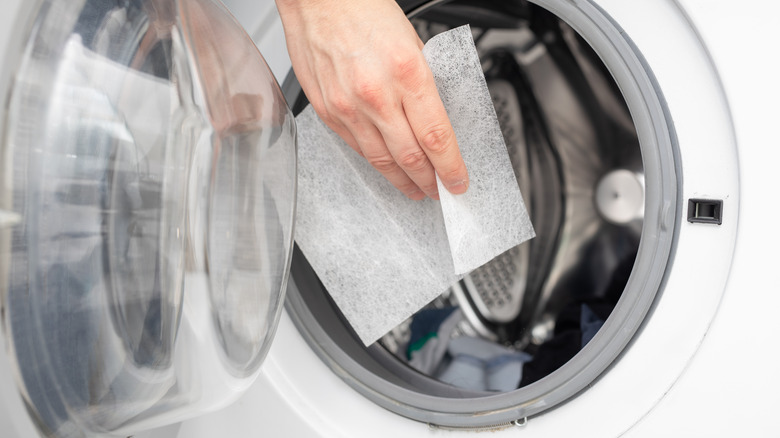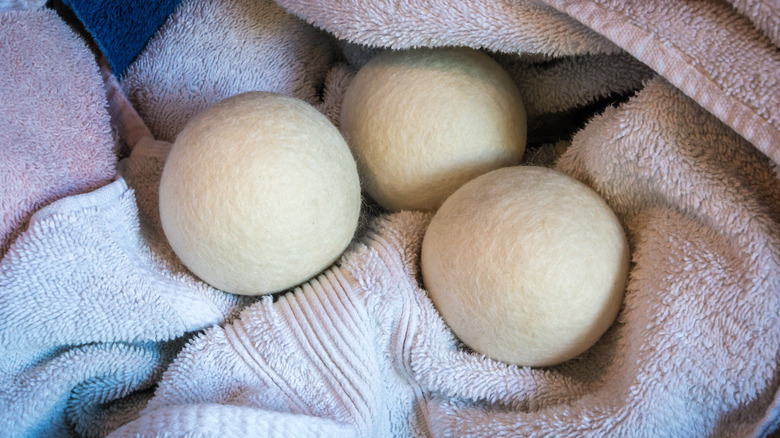Avoid Using Dryer Sheets When Drying Children's Clothes. Here's Why
When it comes to doing the family's laundry, most people try to streamline things as much as possible. Depending on how many people you're cleaning for, those piles of dirty clothes can easily multiply into four to six loads. However, even if you want to make the chore as easy and turnkey as possible, children's clothes require a different set of laundering rules. Many people utilize special infant or toddler laundry detergents in order to protect their kids' delicate skin, but did you know you should also extend that same precaution to the dryer? When it comes to drying children's clothes, you should stop using dryer sheets immediately. The reasons are twofold: They can irritate their sensitive skin much like regular detergent can and make their clothes' flame resistance less effective.
You might want to use dryer sheets to make your kids' clothes extra soft and fluffy. Air drying usually creates a crunchy effect on everything from onesies to summer shorts, and we don't want our kids' skin in contact with rough material all day long. But while the intentions might be good, it's important to understand the potential risks involved.
Dryer sheets can cause rashes and make clothes more susceptible to fire
If you invest in fragrance- and chemical-free detergents to wash your children's clothes, drying them with a dryer sheet will waste your efforts. While these laundry products might seem harmless, they're packed with fiber-softening fragrances and chemicals. For instance, some common chemicals you can find in most commercial sheets include benzyl alcohol, which is a lung irritant; ethanol, which the Environmental Protection Agency (EPA) has classified as hazardous waste; and benzyl acetate, which can irritate the lungs and harm the central nervous system. If your child or infant's skin comes into contact with such ingredients, it can soak in these ingredients and become irritated and break out.
If that's not enough to convince you to skip the dryer sheets, then there is another point to consider. Children's sleepwear and loungewear from size 9 months to size 14 must be flame retardant enough to extinguish a flame if it comes into contact with the material. This helps protect children from injuries from space heaters or candles. However, because dryer sheets release a waxy coating to help smooth and soften fibers, they can make these items less flame-resistant.
What to use instead of dryer sheets
Luckily, there are plenty of other alternatives that can help soften your children's clothes without using dryer sheets. The first one involves no products, and that is to throw the laundry into an air dry cycle. When your items are 80% dry, gather them up, throw them into the dryer, toss in a damp washcloth for added moisture, and turn on the air dry cycle. This will fluff your clothes thanks to the added humidity from the washcloth, and they'll come out softer than they would on a clothesline.
You can also invest in a few wool dryer balls. These are made from 100% wool, and as they bounce around the dryer, they separate the clothing and improve air circulation. This ensures that the clothes won't bunch together, which can cause them to take longer to dry and end up stiff. That same motion helps soften them, ensuring they're cozy on the skin when they come out. If you want to save money on dryer balls, you can also DIY them. Simply take an old wool sweater you no longer want, cut it into strips, wrap those pieces together into a ball, and place them into a pantyhose leg. Put the hose in a pot of boiling water to felt the pieces together, forming a solid ball. That should be all you need to create a repurposed dryer ball.


